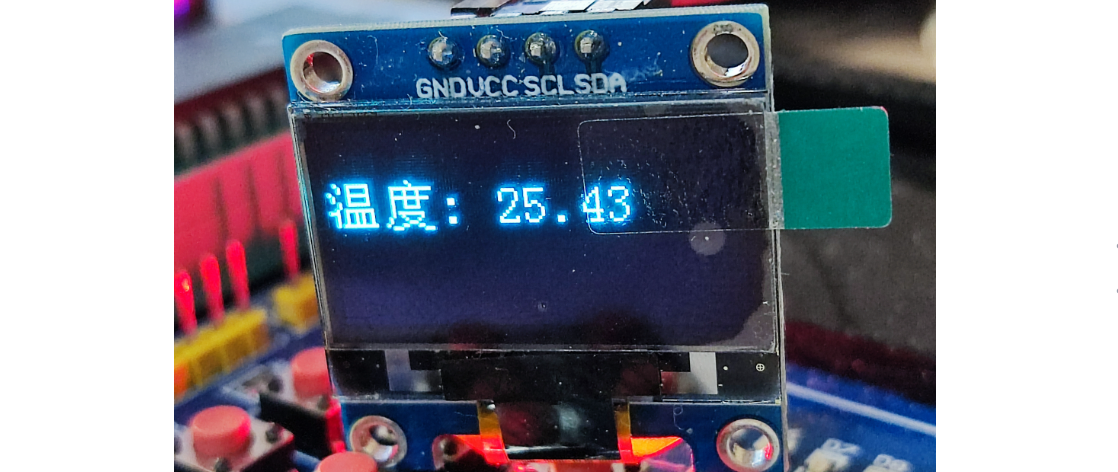一、项目背景
随着人们生活水平的不断提高,对居住环境的舒适度要求也越来越高。空调作为一种重要的家电设备,已经成为了现代家庭中必不可少的一部分。本文介绍了一种基于STM32的智能空调设计方案,可以自动地根据环境温度进行温度调节。


二、设计思路
2.1 整体构架
智能空调系统由温度检测传感器、微控制器、OLED显示屏、按键及直流电源等组件构成。传感器用于检测环境温度,通过微控制器进行处理后,将结果输出到OLED显示屏上展示。按键可根据需求调整预设阀值,切换模式等操作。
2.2 硬件设计
(1)温度检测传感器
选择DS18B20数字温度传感器作为本系统的温度检测器件。该传感器具有精度高,响应速度快等特点,可以满足该系统的检测需求。
(2)微控制器
使用STM32F103系列的微控制器,在该控制器活跃的生态环境下,以及其先进的处理能力,可以对信号进行快速采集、处理和控制。
(3)OLED显示屏
本系统使用的是一块128 * 64 OLED显示屏,显示屏具有高亮度、高对比度和低功耗等优点,易于与STM32微控制器进行通信。
2.3 软件设计
在软件设计方面,实现了温度检测传感器数据的采集,使用处理算法对数据进行处理,根据预设阀值自动调节温度,同时可以根据用户需求,切换制冷、制热和关闭等3种模式。最后,将结果通过OLED显示屏进行输出。
三、代码设计
3.1 DS18B20温度检测代码
#include "main.h"
#include "delay.h"
#define GPIO_PORT_TEMP GPIOA //温度数据引脚所在的端口
#define GPIO_PIN_TEMP GPIO_Pin_0 //温度数据引脚所在的引脚编号
#define RCC_PORT_TEMPP RCC_APB2Periph_GPIOA // 温度引脚所在端口时钟号
void USART_SendByte( USART_TypeDef * pUSARTx, uint8_t ch );
void delay_us(uint32_t us){ // 延时us微秒函数
uint8_t i;
for(i=0;i< us;i++){
asm("nop");
}
}
float get_temp(){ // 获取温度函数
uint16_t temp;
uint8_t buf[2];
GPIO_InitTypeDef GPIO_InitStruct;
TIM_TimeBaseInitTypeDef TIM_InitStruct;
RCC_APB2PeriphClockCmd(RCC_PORT_TEMPP,ENABLE);
//DATA拉低480us复位
GPIO_InitStruct.GPIO_Mode = GPIO_Mode_Out_PP;
GPIO_InitStruct.GPIO_Pin = GPIO_PIN_TEMP;
GPIO_InitStruct.GPIO_Speed = GPIO_Speed_50MHz;
GPIO_Init(GPIO_PORT_TEMP , &GPIO_InitStruct);
GPIO_ResetBits(GPIO_PORT_TEMP , GPIO_PIN_TEMP );
delay_us(500);
GPIO_SetBits(GPIO_PORT_TEMP , GPIO_PIN_TEMP );
delay_us(60);
//查询DS18B20是否存在
GPIO_InitStruct.GPIO_Mode = GPIO_Mode_IPU;
GPIO_InitStruct.GPIO_Pin = GPIO_PIN_TEMP;
GPIO_Init(GPIO_PORT_TEMP , &GPIO_InitStruct);
while (GPIO_ReadInputDataBit(GPIO_PORT_TEMP , GPIO_PIN_TEMP ) == RESET);
//通信开始
GPIO_ResetBits(GPIO_PORT_TEMP , GPIO_PIN_TEMP );
delay_us(480);
GPIO_SetBits(GPIO_PORT_TEMP , GPIO_PIN_TEMP );
delay_us(60);
//读取温度数据
GPIO_InitStruct.GPIO_Mode = GPIO_Mode_IPU;
GPIO_InitStruct.GPIO_Pin = GPIO_PIN_TEMP ;
GPIO_Init(GPIO_PORT_TEMP , &GPIO_InitStruct);
delay_us(10);
if (GPIO_ReadInputDataBit(GPIO_PORT_TEMP , GPIO_PIN_TEMP ) == RESET){
temp |=0x01;
}
else{
temp &=0xfe;
}
delay_us(50);
if (GPIO_ReadInputDataBit(GPIO_PORT_TEMP , GPIO_PIN_TEMP ) == RESET){
temp |=0x02;
}
else{
temp &=0xfd;
}
delay_us(50);
if (GPIO_ReadInputDataBit(GPIO_PORT_TEMP , GPIO_PIN_TEMP ) == RESET){
temp |=0x04;
}
else{
temp &=0xfb;
}
delay_us(50);
if (GPIO_ReadInputDataBit(GPIO_PORT_TEMP , GPIO_PIN_TEMP ) == RESET){
temp |=0x08;
}
else{
temp &=0xf7;
}
delay_us(50);
if (GPIO_ReadInputDataBit(GPIO_PORT_TEMP , GPIO_PIN_TEMP ) == RESET){
temp |=0x10;
}
else{
temp &=0xef;
}
delay_us(50);
if (GPIO_ReadInputDataBit(GPIO_PORT_TEMP , GPIO_PIN_TEMP ) == RESET){
temp |=0x20;
}
else{
temp &=0xdf;
}
delay_us(50);
if (GPIO_ReadInputDataBit(GPIO_PORT_TEMP , GPIO_PIN_TEMP ) == RESET){
temp |=0x40;
}
else{
temp &=0xbf;
}
delay_us(50);
if (GPIO_ReadInputDataBit(GPIO_PORT_TEMP , GPIO_PIN_TEMP ) == RESET){
temp |=0x80;
}
else{
temp &=0x7f;
}
delay_us(50);
//读取温度小数点数据
if (GPIO_ReadInputDataBit(GPIO_PORT_TEMP , GPIO_PIN_TEMP ) == RESET){
buf[0] |=0x01;
}
else{
buf[0] &=0xfe;
}
delay_us(50);
if (GPIO_ReadInputDataBit(GPIO_PORT_TEMP , GPIO_PIN_TEMP ) == RESET){
buf[0] |=0x02;
}
else{
buf[0] &=0xfd;
}
delay_us(50);
if (GPIO_ReadInputDataBit(GPIO_PORT_TEMP , GPIO_PIN_TEMP ) == RESET){
buf[0] |=0x04;
}
else{
buf[0] &=0xfb;
}
delay_us(50);
if (GPIO_ReadInputDataBit(GPIO_PORT_TEMP , GPIO_PIN_TEMP ) == RESET){
buf[0] |=0x08;
}
else{
buf[0] &=0xf7;
}
delay_us(50);
if (GPIO_ReadInputDataBit(GPIO_PORT_TEMP , GPIO_PIN_TEMP ) == RESET){
buf[0] |=0x10;
}
else{
buf[0] &=0xef;
}
delay_us(50);
if (GPIO_ReadInputDataBit(GPIO_PORT_TEMP , GPIO_PIN_TEMP ) == RESET){
buf[0] |=0x20;
}
else{
buf[0] &=0xdf;
}
delay_us(50);
if (GPIO_ReadInputDataBit(GPIO_PORT_TEMP , GPIO_PIN_TEMP ) == RESET){
buf[0] |=0x40;
}
else{
buf[0] &=0xbf;
}
delay_us(50);
if (GPIO_ReadInputDataBit(GPIO_PORT_TEMP , GPIO_PIN_TEMP ) == RESET){
buf[0] |=0x80;
}
else{
buf[0] &=0x7f;
}
delay_us(50);
return (float)temp+((float)buf[0]/16.0); // 将温度整数位和小数位转换为十进制
}
int main(void){
char temp_buf[20]; // 接收温度值的临时缓冲区
USART_InitTypeDef USART_InitStruct;
RCC_APB2PeriphClockCmd(RCC_APB2Periph_USART1,ENABLE);
RCC_AHBPeriphClockCmd(RCC_AHBPeriph_DMA1,ENABLE);
USART_InitStruct.USART_BaudRate = 115200;
USART_InitStruct.USART_HardwareFlowControl = USART_HardwareFlowControl_None;
USART_InitStruct.USART_Mode = USART_Mode_Rx | USART_Mode_Tx;
USART_InitStruct.USART_Parity = USART_Parity_No;
USART_InitStruct.USART_StopBits = USART_StopBits_1;
USART_InitStruct.USART_WordLength = USART_WordLength_8b;
USART_Init(USART1,&USART_InitStruct);
USART_Cmd(USART1,ENABLE);
while(1){
float temp_get=get_temp(); // 获取当前温度值
sprintf(temp_buf,"temp:%0.1f
",temp_get); // 将温度值格式化为字符串输出
for(int i=0;i< strlen(temp_buf);i++){ // 逐字符发送温度值至串口
USART_SendByte(USART1,temp_buf[i]);
}
delay_ms(1000); // 延时1s后再次获取温度值
}
}
void USART_SendByte( USART_TypeDef * pUSARTx, uint8_t ch ){
while(USART_GetFlagStatus(pUSARTx,USART_FLAG_TXE) == RESET);
USART_SendData(pUSARTx,ch);
相关文章

















 技术咨询
技术咨询 代买器件
代买器件 商务客服
商务客服 研发客服
研发客服